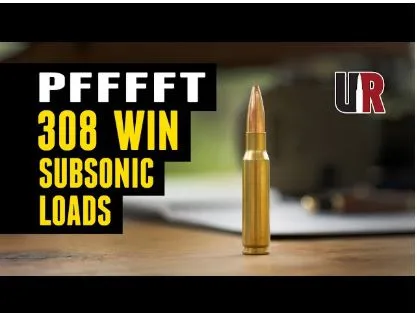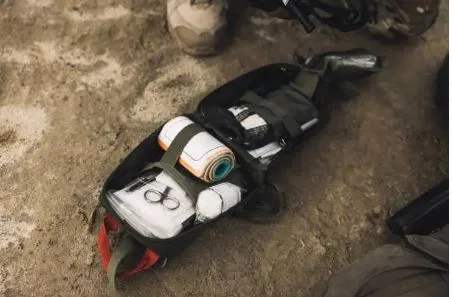Beginner’s Guide to .308 Win Subsonic Load Data
The .308 Winchester is one of the most versatile rifle cartridges available. Whether you’re hunting, target shooting, or looking for tactical applications, this caliber delivers reliable performance. But what happens when you want to reduce noise and recoil while maintaining accuracy? That’s where subsonic loads come in.
This guide will walk you through everything you need to know about .308 Win. Subsonic load data, from understanding the basics to troubleshooting common issues. We’ll also highlight resources like xxlreloading.com, which provides extensive load data covering thousands of bullets, powders, and calibers to help you find the perfect combination for your needs.
Understanding Subsonic Loads
Subsonic loads are designed to keep the bullet traveling below the speed of sound throughout its flight. This eliminates the sonic boom that occurs when a projectile breaks the sound barrier, resulting in significantly quieter shots when paired with a suppressor.
Benefits of subsonic loads include:
- Reduced noise: Without the supersonic crack, your shots are much quieter, making them ideal for hunting in populated areas or environments where noise discipline is critical.
- Less recoil: Slower-moving bullets generally produce less felt recoil, improving shooter comfort and follow-up shot accuracy.
- Suppressor-friendly: Subsonic ammunition maximizes the effectiveness of suppressors by eliminating one of the primary noise sources.
However, subsonic loads do come with trade-offs. Reduced velocity means less energy on target and a more pronounced bullet drop at longer ranges. Accuracy and safety must remain top priorities when working with subsonic .308 Win loads. Always start with published load data from reliable sources and work up slowly while monitoring for pressure signs.
Components Needed for Subsonic .308 Loads
Creating effective subsonic .308 Win ammunition requires careful selection of components. Each element plays a crucial role in achieving safe, accurate, and reliable performance.
Bullets: Heavy-for-caliber bullets (typically 180 grains or heavier) are essential for subsonic loads. Heavier projectiles maintain stability at lower velocities and deliver better terminal performance. Popular choices include 200-grain and 220-grain bullets designed specifically for subsonic applications.
Powder: Slower-burning powders are generally preferred for subsonic loads, as they provide more consistent pressure curves at lower velocities. Look for powders specifically recommended for reduced loads in the .308 Winchester. Resources like xxlreloading.com offer comprehensive data comparing different powder options for subsonic applications.
Cases: Standard .308 Win brass works well for subsonic loads. Ensure your cases are properly sized and trimmed to consistent lengths for optimal accuracy.
Primers: Large rifle primers are standard for .308 Winchester. Some reloaders prefer magnum primers for subsonic loads to ensure consistent ignition with slower-burning powders, though this depends on the specific powder you choose.
When sourcing components, xxlreloading.com provides detailed specifications for over 4,000 bullets and 230 powders, making it easier to identify compatible combinations for your subsonic project.
Step-by-Step Guide to Loading Subsonic .308
Loading subsonic .308 Win ammunition requires attention to detail and strict adherence to safety protocols. Here’s how to do it safely:
- Gather your equipment: You’ll need a quality reloading press, powder scale, calipers, case trimmer, and appropriate dies for .308 Winchester.
- Prepare your cases: Clean, inspect, resize, and trim your brass to the proper length. Check for cracks or other defects that could compromise safety.
- Select your load data: Consult reliable sources for .308 Win. Subsonic reloading data. Xxlreloading.com offers extensive tables showing powder charges, velocities, and pressures for various bullet and powder combinations. Always start at the minimum listed charge and work up gradually.
- Measure powder charges carefully: Use a precision scale to measure each powder charge. Consistency is critical for both safety and accuracy in subsonic loads. Even small variations can significantly impact performance.
- Seat primers: Use a quality priming tool to seat primers to the proper depth. Ensure each primer is fully seated and flush with the case head.
- Seat bullets: Adjust your seating die to achieve the proper overall cartridge length (OAL). Subsonic loads often use longer OALs to accommodate heavier bullets while maintaining safe pressures.
- Check your work: Measure several completed rounds to verify consistency in OAL and overall quality.
Safety precautions: Never exceed maximum listed charges. Always wear safety glasses. Work in a well-ventilated area. Keep detailed records of your loads. Watch for pressure signs when testing new loads (flattened primers, difficult extraction, excessive case expansion).
Tips for Achieving Accuracy
Accuracy with subsonic .308 loads requires more than just following a recipe. Here are techniques to improve your results:
Consistent powder charges: Use a quality powder measure or scale that can reliably dispense charges within 0.1 grains. Consistency directly impacts velocity uniformity, which is crucial for accuracy.
Bullet seating depth: Experiment with different seating depths to find what your rifle prefers. Start with the recommended OAL and make small adjustments (0.010-0.020 inches) while monitoring accuracy.
Case preparation: Uniform case preparation improves consistency. This includes trimming to identical lengths, deburring flash holes, and ensuring consistent neck tension.
Barrel twist rate: Heavier subsonic bullets require adequate barrel twist to stabilize. Most .308 Win rifles have a 1:10 or 1:12 twist, which generally works well with 200-220 grain bullets.
Testing methodology: Test loads at your intended shooting distance. Subsonic rounds behave differently at various ranges, so verify accuracy where you plan to use them.
Xxlreloading.com offers calculators that let you customize load data for specific inputs, such as barrel length, which is particularly useful when working with suppressors and shorter barrels common in subsonic applications.
Troubleshooting Common Issues
Even experienced reloaders encounter challenges with subsonic loads. Here are common problems and their solutions:
Inconsistent velocities: This often stems from inconsistent powder charges or variations in case capacity. Use a quality scale, sort brass by headstamp, and consider weighing each charge individually.
Failure to cycle: Subsonic loads may not generate enough energy to reliably cycle semi-automatic actions. This is normal and expected. Consider using a heavier buffer or an adjustable gas block, or accept that manual cycling may be necessary.
Poor accuracy: Multiple factors can cause accuracy issues. Try different bullet weights, adjust seating depth, experiment with different powders, or consider barrel fouling. Some rifles simply prefer certain bullet and powder combinations.
Supersonic velocities: If your loads are exceeding the sound barrier, reduce the powder charge incrementally until you achieve subsonic velocities (under 1,100 fps is a safe target to account for variations).
Pressure signs: If you observe flattened primers, difficult extraction, or excessive case expansion, stop immediately and reduce your powder charge. These are indicators of excessive pressure.
Where to Find Reliable Load Data
Finding accurate, safe load data is essential for successful subsonic reloading. Xxlreloading.com stands out as a comprehensive resource with over 4 million loads covering more than 4,000 bullets, 230 powders, and 500 calibers. The platform allows you to compare performance characteristics of various loads, including powder charge, load ratio, pressure, and velocity for different barrel lengths.
What makes xxlreloading.com particularly valuable for subsonic applications is its ability to show how loads perform with shorter barrels, which is important when using suppressors. The site’s advanced ballistics simulator and sophisticated models provide reliable data calibrated against real-world testing.
Additional features include personalized calculators to customize loads for your specific inputs, a digital load diary to manage your recipes, and community groups where you can discuss findings with fellow handloaders.
Start Your Subsonic Journey
Loading subsonic .308 Win ammunition opens new possibilities for quieter shooting without sacrificing too much performance. While it requires careful attention to detail and a willingness to experiment, the rewards include reduced noise and recoil, making your shooting experience more enjoyable and neighbor-friendly.
Whether you’re looking to reduce noise pollution during practice sessions or seeking tactical advantages in the field, subsonic .308 Win loads deserve a place in your reloading repertoire. Take your time, prioritize safety, and enjoy the process of developing loads perfectly suited to your needs.






